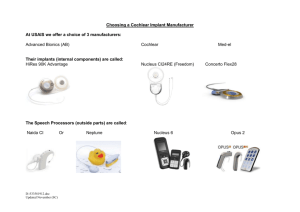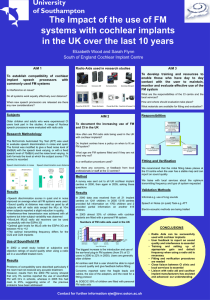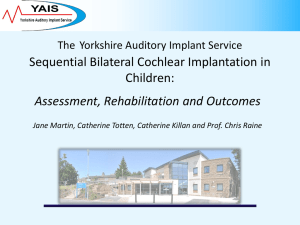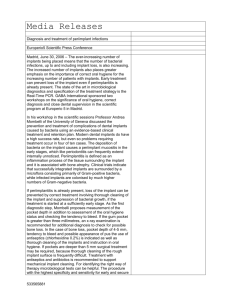Device Choice – 3 Manufacturers Children
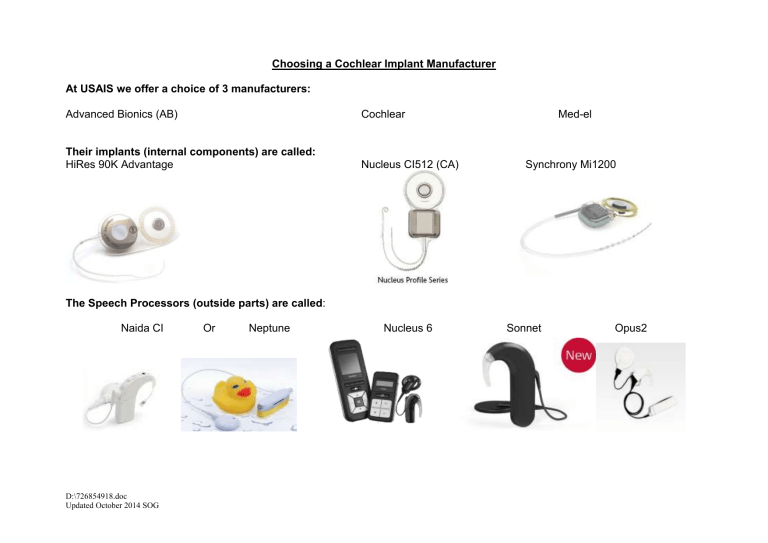
Choosing a Cochlear Implant Manufacturer
At USAIS we offer a choice of 3 manufacturers:
Advanced Bionics (AB)
Their implants (internal components) are called:
HiRes 90K Advantage
Cochlear
Nucleus CI512 (CA)
Med-el
Synchrony Mi1200
The Speech Processors (outside parts) are called :
Naida CI Or Neptune Nucleus 6 Sonnet Opus2
D:\726854918.doc
Updated October 2014 SOG
Help!
What if I can’t decide which make of implant to choose?
We recommend that you:
look at the manufacturers’ websites http://www.advancedbionics.com
(for Advanced Bionics) www.cochlear.com
(for Cochlear) www.medel.com
(for Med-el)
read their literature
consider the following differences listed below
discuss your own requirements with the team and ask any questions.
If you are unable to decide, do not worry! Patients do well with all systems otherwise USAIS would not offer a choice.
Frequently Asked Questions
Implants and internal workings
Which make has the most reliable internal part (implant)?
All manufacturers strive to maintain high reliability levels and all have occasional failures.
Which implant requires the smallest amount of drilling during surgery?
All of the implants require the same amount of drilling during surgery. The HiRes90K Advantage implant requires a slightly larger surgical entry into the cochlea.
Which cochlear implant sounds better?
This is impossible to answer. All implants sound very strange at first but the user gradually gets used to them. The implants from all 3 manufacturers are adjusted through tuning to make the sound audible and comfortable. The implant will normally sound better over time.
Which implant is better in noisy conditions?
The 3 implant manufacturers use different techniques to help implant users in background noise. There is a very wide variation in p eople’s outcomes so it is difficult to say which is best.
The latest MED-EL speech processing incorpor ates ‘FineHearing’ which gives more fine-structure information which may give better speech understanding in noise; it also uses two microphones which can help in noisy environments. The Advanced Bionics processing uses a ‘current steering’ technique which creates additional ‘virtual channels’ between the electrodes. This gives a ‘crisper’ signal which may help in background noise. They also use ClearVoice and Ultra Zoom which are noise reducing techniques. Nucleus uses 2 microphones which facilitate a noise cancelling system called BEAM which enhances sounds from front. Nucleus also uses autosensitivity (ASC), a noise reducing technique, which helps to eliminate steady background noises.
D:\726854918.doc
Updated October 2014 SOG
Which implant performs best with music?
There are limitations with all implants with music perception as implants are generally designed to give the best speech intelligibility. Recently there has been more of a focus on music appreciation and the implant companies have come up with different ways of improving the quality of music. Medel’s implant speech processing incorporates ‘FineHearing’ which gives more fine-structure information which may give better music appreciation. The Advanced Bionics processing uses a ‘current steering’ technique which creates additional ‘virtual channels’ between the electrodes. This has been shown to give more musical appreciation to implant users who had been changed over from a previous strategy.
Cochlear have recently developed a map setting aimed at improving music appreciation.
Which manufacturer is easier to tune (programme or map) for Children?
Advanced Bionics and Med-el users require fewer measurements to tune their implants as they only require measurements of the loudest comfortable sounds on individual electrodes
. Cochlear’s implant requires measurements of the loudest comfortable sound and also the quietest level at which they can hear on individual electrodes.
Where are the cochlear implants made and which company has been making implants for longer?
AB is an American company, Med-el is Austrian and Cochlear Corporation is Australian. Cochlear has the longest history of implant manufacturing.
Are there differences in the designs of the electrode arrays (the part that enters the cochlea)?
The HiRes90K Advantage array has a curved tip which is designed to go around one and a quarter turns of the cochlea mid-way between the inner part of the cochlea (modiolus) and the outer wall. Its active electrode length is 15mm. The CI512 (CA) has a tighter curve to fit around the middle of the cochlea. Its active electrode array length is 15mm. The Synchrony Flex28 has the longest array (28mm) which is designed to go deeper into the cochlea.
Can I have an MRI scan with any of the manufacturers?
It is important to check with your surgeon before having an MRI scan regardless of the make you choose.
An MRI scan can be performed with any of the implants in place (with the surgeon’s permission) up to a certain magnetic field strength without removing the implant or magnet. The HiRes90K, Synchrony and the Cochlear Nucleus implants are designed so that the magnet can be removed when undergoing an MRI scan, rather than the whole implant if necessary. With the magnet in place an MRI can be performed at up to 1.5 Tesla for the Cochlear CI512CA implants. With magnet removed the HiRes 90K is compatible for MRI at 0.3 and 1.5 Tesla. For the
Medel Synchrony implant with the magnet in place, an MRI can be performed up to 3 Tesla.
The stated maximum scan strengths are the limits to avoid damage to the implant or surrounding head tissue. Some people may experience some discomfort or pain at these levels. In these cases, it may be necessary to remove the magnet, perform a lower-intensity scan or find an alternative diagnostic test.
D:\726854918.doc
Updated October 2014 SOG
Speech Processors (outside parts) and accessories
Are there different colours for each manufacturer?
Yes, but we ask you to choose a “base” colour for each of the manufacturers.
Do any of the speech processors have a remote control?
Yes, the Nucleus 6 has a remote assistant/remote control but nearly all the functions of the remote assistant are accessible by pushing some button on the processor. The Sonnet comes with a Fine tuner (like a remote control) which is used to change programmes etc. The Neptune does not have a remote control. Naida CI comes with comPilot and my pilot. MyPilot is an optional extra.
Do all the manufacturers have inbuilt Telecoil “T” switches, for use with loop systems?
The Nucleus 6 has a button on the processor or on the remote assistant/remote control; the Synchrony has a button to press on the Fine
Tuner. On the Naida CI, need to use the program changing switch to activate telecoil.
Are all speech processors waterproof?
The Neptune is waterproof and the Naida CI is splash proof - it can tolerate rain, humidity and sweat. Waterproofing equipment can be bought for personal us, the cost will be in the region of £500-00. The Sonnet is splash proof to a standard of IP54 and a pack of “Rondo WaterWear” covers can be purchased separately for aroun d £20 per pack. The Nucleus 6 is splash proof to a standard of IP57 and the cochlear aqua+ which is a waterproofing option is provided free by Cochlear (although there is currently no baby worn option for this), USAIS does not guarantee to replace the Aqua+ if it becomes faulty.
Can you directly plug into Stereos, MP3 players etc using accessory cables with each manufacturer?
With Cochlear Nucleus 6 you can connect a lead to listen to battery operated equipment or you can choose one of three different wireless options: The MiniMic, The Phone Clip or the TV Streamer. Advanced Bionics and Med-el do not produce a mains operated cable but
Connevans makes a compatible cable. Naida CI uses compilot to stream music into your processor/s. Medel Sonnet processor can use a neckloop to stream to other devices wirelessly; this may need to be purchased separately.
Does CI equipment effect implanted Pacemaker/Defibrillator systems?
Some CI equipment radiates electromagnetic energy that will affect Pacemaker and Defibrillator systems if they are operated in close proximity of each other. Please discuss this with us at your assessment appointments if you or someone close to you has one of these systems implanted.
Are the microphones the same?
No. The Naida CI has several different earhooks/microphones for different uses. Its T mic is an ear hook which positions the microphone in the concha of the ear which takes advantage of the natural collection of sound. The microphone for the Neptune is on the headpiece. There are 2 omni directional microphones on the Nucleus 6. The Sonnet speech processor has two omni-directional microphone.
D:\726854918.doc
Updated October 2014 SOG
Do all systems have an alarm to alert you to the fact that the batteries are low?
Yes
Housing of implant
Number of channels
Advanced Bionics – HiRes 90K
Advantage
Titanium case
Silicone enclosure
16 channels
Makes use of current steering to create virtual channels
Cochlear – CI512CA
Titanium case
Silicone enclosure
22 channels
Diagnostics
MRI Safety
Telemetry (implant test)
NRI
Integrity testing
Need to check with surgeon first
Internal magnet is removable
With magnet removed, MRI can be performed at 0.3 and 1.5 Tesla
Telemetry (implant test)
NRT
Integrity testing
Need to check with surgeon first
Internal magnet is removable
With magnet in place, MRI can be performed up to 1.5 Tesla
Medel – Synchrony Flex28
Titanium case
Silicone enclosure
12 channels
Telemetry (implant test)
ART
Integrity testing
Need to check with surgeon first
Internal magnet is removable
With magnet in place, MRI can be performed up to 3.0 Tesla
Tuning
Measurements of loudest comfortable levels only
Uses current steering to create virtual channels – reports of help in background noise situations and music appreciation
Measurements of quietest levels and loudest comfortable levels
Uses Zoom or BEAM – reports of reduction of background noise
Measurements of loudest comfortable levels only
Uses fine hearing – reports of help in background noise situations and music appreciation
D:\726854918.doc
Updated October 2014 SOG
Advanced Bionics processor
– Neptune Advanced Bionics
Processor
– Naida CI Cochlear – CI512 CA with
NUCLEUS 6 processor
Medel – Sonnet processorSonnet processor – if you were to choose this processor you may be issued with the Opus 2 processor in the short term until the
Sonnet processor is ready to be issued.
Processor information
4 Number of programs
User controls
3
On/off control button on processor
Program selector
Volume wheel
5
Battery type
AAA batteries
3 rechargeable batteries
(processor needs one at a time)
Optional disposable batteries
Average battery life
Change batteries every day
Power cell Batteries available in 3 sizes: up to 16
Range of colours available***
Wearing options
Processor: black, white
Colour covers: black, sand, ocean blue, sky blue, tropical sea, lime green, violet, red, pink, white
Off the ear on an armband, harness, lanyard, swim headband or swim cap hours
Optional disposable batteries up to 30 hours
Processor: Silver,
Caribbean pirate, Ruby, Sand,
Pink, Chestnut, White and
Black.
Various colour caps for headpiece
Behind the ear (BTE)
Off the ear option using
Naida Clips, Light wear option
D:\726854918.doc
Updated October 2014 SOG
hours
Zinc air: up to 2 days
Standard rechargeable: 17
Remote assistant: 1-2 wks
Processor: Carbon, Maize,
Mocha & Smoke
Processor covers available in various colours
Behind the ear (BTE)
Body worn option (two battery racks needed if bilateral
4
Off: disconnection of battery
Program selector
Volume button
Push button: on/off, program selector, volume, sensitivity
Lock function
Remote assistant with LCD display with help messages
Pocket-sized remote control, with a handy display screen allows you to adjust simple settings
2 zinc air batteries or
standard rechargeable batteries
Fine tuner: program
selector, volume, sensitivity
2 zinc air batteries
Rechargeable batteries – not currently available
Zinc air: up to 60hrs
Rechargeable battery: 10 hrs
Battery for fine tuner: 6mths-
1 year
Processor: Black, Nordic grey, Beige, Anthracite,
Ebony and White.
Behind the ear (BTE)
Accessories available
Data logging capability
Telecoil via Tcom (for use with a loop system)
Microphone on headpiece
Cables to link up to external accessories
Built-in indicator light
Monitor earphone (to check microphone)
Coloured covers for coil and processor
Radio aid compatible
Not currently available
Splash proof processor
Optional waterproofing accessory available
Built in telecoil (for use with a loop system)
T-Mic: microphone that sits in the ear
Standard earhook
Built-in indicator light (can be switched off if not required)
LED: to check coil and microphone
Coloured covers for coil
Radio aid compatible via comPilot
Monitor earphone (to check microphone)
Yes
Provides information on hours of use, program usage, environmental loudness, feature usage, control usage and number of times the coil is off.
15% Average monthly return rate (this is the percentage of processors that are returned for repair over a 6 month period (May-
October 2014) #
Holiday loaners
8%
£30 per trip for one processor
Processor sent to you before your trip and needs to be returned after
If not returned in 30 days
D:\726854918.doc
Updated October 2014 SOG
£30 per trip for one processor
Processor sent to you before your trip and needs to be returned after
If not returned in 30 days
CI)
Splash proof processor
Optional cochlear aqua accessory for waterproofing
Built in telecoil (for use with a loop system)
Standard earhook
Cables to link up to external accessories
Built-in indicator light (can be switched off if not required)
Monitor earphone (to check microphone)
Coloured covers for processor
Radio aid compatible
Yes
Provides information on program usage, accessory usage, different listening environments, number of times coil is off and environmental loudness.
1%
Options
Annual cover plan – loaner shipped to you if a problem
– 1 year cover - pp£95 pfamily - £135
Single trip plan – loaner
Splash proof processor
Built in telecoil (for use with a loop system)
Standard earhook
Dual microphone
Cables to link up to external accessories
Built-in indicator light
Signal check (to check coil)
Radio aid compatible
Yes
Provides information on processor usage, program usage, number of switch ons per day, overall days logged, volume control range, sensitivity control range
Data not currently available
£25 per trip for one processor
Processor sent to you before your trip and needs to be returned after
Standard loan period 30
after the loan period a charge of
£10 per day will apply for 10 days
If not returned within 40 days invoice for £2,500 after the loan period a charge of
£10 per day will apply for 10 days
If not returned within 40 days invoice for £2,500 shipped –£20pp, £40 per family (duration of plan 2 weeks)
Full back up plan – loaner provided –£80 per processor, £30 for second processor (bilateral recipients only) (duration of plan 2 weeks)
On the annual cover and single trip plans the sound processor will be with you in approximately 2 days
If the processor has been damaged, misused or lost there is a fee of £2000. days
If the processor is lost or not returned within the agreed loan period there is a £1000 charge.
SPECIAL OFFERS FROM ADVANCED BIONICS
1) Grow With You Offer: children of pre-school age who choose a Neptune can transfer to a Naida but this must take place within 2 years of the initial fitting. This offer is valid until 31 December 2015.
2) Advanced Bionics are also offering their Aquakit for 50% off, in conjunction with their certified retail partners, before
30 September 2015.
Reliability data for cochlear implants
All the companies have experienced some problems with their implants at some time. The table below lists the reliability data as defined and published by the companies for their most recent implants (the ones which are being used at the moment).
D:\726854918.doc
Updated October 2014 SOG
Company Implant Date information issued by company
Nov 2014
Company reliability data for the implants
(this includes data for implants that have failed and those that needed to be explanted due to accident related issues)
99.81% survival rate at 1 year
Advanced Bionics HiRes 90K
Advantage
Cochlear
MED-EL
CI512CA
Concerto
Awaiting data**
July 2013 99.07% survival rate at 3 years
* Since this implant has only been in use for less than 1 year, we are also giving you the data published by the company for the previous implant they used
– the Hi Res 90K implant – this is not the implant that you would be getting should you choose the AB device. This data showed
98.08% survival rate at 6 years
.
** Since this implant has only been in use for less than 1 year, we are also giving you the data published by the company for the previous implant they used
– the CI24RE – this is not the implant you would be getting should you choose the Cochlear device.
This showed a 98.8% survival rate at 7 years.
*** These are the only colours AIS offer; there might be other colours the manufacturers offer.
# data is presented to the nearest percent. This is from both adult and paediatric returns.
D:\726854918.doc
Updated October 2014 SOG

